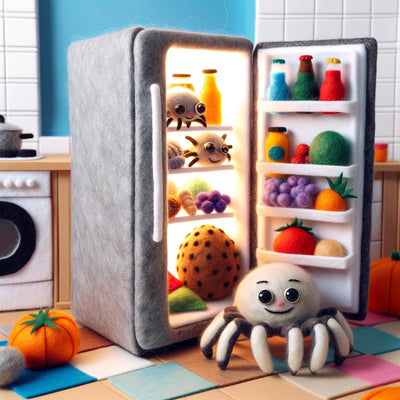Understanding Column Freezers and Outdoor Refrigerators
Introduction to Column Freezers and Outdoor Refrigerators
When you're considering an upgrade to your home refrigeration setup or simply exploring options for additional storage, understanding the specifics of different appliance types is essential. Two distinct categories that might catch your attention are column freezers and outdoor refrigerators. Each serves a unique purpose and offers specific benefits for storage and convenience. Whether you live in an apartment, condo, or have a spacious family home, knowing the capabilities of these units can help in making an informed decision tailored to your refrigeration needs.
Key Differences Between Column Freezers and Outdoor Refrigerators
Column freezers and outdoor refrigerators differ in several aspects, including their designed environment, storage capacity, and features. To help you grasp their differences, a comparison table is provided below.
| Feature | Column Freezer | Outdoor Refrigerator |
|---|---|---|
| Designed Environment | Indoors | Outdoors |
| Temperature Range | Below 0°F | Above 32°F |
| Storage Capacity | Varies, often larger | Typically smaller |
| Defrost System | Automatic | Automatic/Manual |
| Security | Lock options | Weatherproofing, Lock options |
| Insulation | Standard | Enhanced for outdoor conditions |
| Energy Consumption | Varies, energy-efficient models available | Varies, energy-efficient models available |
Column freezers are designed primarily for indoor use, possibly in a basement or garage. They are ideal for long-term storage of frozen goods and often come with a variety of shelving and bin options to keep your items organized. On the other hand, outdoor refrigerators are built to withstand external conditions, making them perfect for patios or outdoor kitchen spaces. They are great for keeping beverages and perishables chilled during outdoor gatherings or family events.
When deliberating on a column freezer versus an outdoor refrigerator, consider the specific needs of your space, whether it's for entertaining, convenience, or bulk storage. Additionally, factor in the energy efficiency, which can impact your utility bills and carbon footprint. For more insights on this topic, explore articles like energy efficiency of column freezers and energy efficiency of outdoor refrigerators.
The decision between a column freezer and an outdoor refrigerator hinges on your lifestyle, the climate you live in, and how you plan to use the additional refrigeration space. By understanding these key differences, you'll be in a better position to choose an appliance that aligns with your needs and enhances your living space.
Column Freezers Explained
Column freezers, also known as upright or stand-alone freezers, offer dedicated freezing space for your home. They are designed to provide a long-term storage solution for frozen foods, making them an indispensable appliance for households that require additional freezing capacity beyond what a standard refrigerator freezer can offer.
Features and Functions of Column Freezers
Column freezers come with a variety of features that cater to the preservation of frozen goods:
- Temperature Control: Most column freezers are equipped with precise temperature controls, allowing you to maintain the optimal freezing environment for different types of food.
- Frost-Free Technology: This function prevents ice buildup, eliminating the need for manual defrosting.
- Adjustable Shelving: Flexible storage solutions with adjustable and sometimes removable shelves and bins.
- Fast Freeze Option: Quickly lowers the temperature to freeze items faster, which is ideal for preserving nutrients in fresh food.
- Door Alarms: Alerts you if the door is not securely closed, helping to maintain the internal temperature and prevent energy waste.
Column freezers can be integrated into your kitchen design or placed in secondary locations, such as a garage or basement. They are available in a range of sizes and capacities to fit various household needs. For comparisons with other freezer types, you might want to explore basement refrigerator vs. tall refrigerator or garage freezer vs. small upright freezer.
Pros and Cons of Column Freezers
Before deciding if a column freezer is the right choice for you, consider the following advantages and disadvantages:
Pros:
- Large Capacity: Offers more space for bulk storage and organization.
- Energy Efficient: Many models are designed to be energy efficient, reducing electricity costs over time.
- Convenience: Easy access to items without having to bend down, as with chest freezers.
- Visibility: Better visibility and organization of contents due to the upright design.
Cons:
- Footprint: Takes up more vertical space, which may be a consideration for smaller homes.
- Price: Generally more expensive upfront than other types of freezers, like chest freezers.
- Temperature Fluctuations: Some models may experience greater temperature fluctuations with frequent door openings.
Understanding the features and weighing the pros and cons of column freezers will aid you in making an informed decision that aligns with your freezing needs and lifestyle. For a deeper dive into the topic, check out our comparative articles such as column freezer vs. ice cream cooler and all freezer refrigerator vs. wine refrigerator.
Outdoor Refrigerators Explained
Outdoor refrigerators are specialized cooling appliances designed to withstand external elements, providing convenient access to food and beverages while you're enjoying the outdoors. Whether you're entertaining guests on the patio or need extra storage for garden parties, these refrigerators offer robustness and performance.
Features and Functions of Outdoor Refrigerators
Outdoor refrigerators come equipped with features that cater to the demands of external environments:
- Weather-resistant construction: Designed with materials that resist corrosion, UV rays, and varying weather conditions.
- Temperature consistency: Engineered to maintain reliable cooling temperatures in fluctuating outdoor temperatures.
- Lockable doors: Security features to safeguard contents.
- Adjustable shelving: Flexibility to store a variety of food and beverage items.
- Compact design: Suitable for fitting into outdoor kitchen spaces or standalone units.
Considering their specialized nature, outdoor refrigerators often come in various sizes and styles, from undercounter models to full-height units, to suit different outdoor layouts and preferences. For comparisons with other refrigeration options, see our articles on beverage center vs. standard fridge size and all freezer refrigerator vs. freestanding wine cooler.
Pros and Cons of Outdoor Refrigerators
| Pros | Cons |
|---|---|
| Durability: Built to last in outdoor conditions. | Cost: Typically more expensive than indoor models. |
| Convenience: Easy access to food and drinks while outside. | Energy Efficiency: May use more energy to combat external temperatures. |
| Entertainment: Enhances outdoor living spaces for hosting events. | Maintenance: May require more frequent cleaning due to outdoor exposure. |
| Design: Often features stylish finishes that complement outdoor decor. | Weather Dependency: Performance can be affected by extreme weather conditions. |
When considering an outdoor refrigerator, it's important to balance the convenience and aesthetic appeal with the practical aspects such as energy consumption and maintenance. These units can be a fantastic addition to your outdoor living space, offering both functionality and style. For those who entertain frequently, the benefits of having refreshments at arm's reach can far outweigh the drawbacks. If you're interested in exploring other refrigeration options that may be suitable for less exposed areas or specific storage needs, check out our comparisons, such as basement refrigerator vs. standard refrigerator size and freestanding beverage center vs. ice cream refrigerator.
Installation Considerations
When it comes to setting up your column freezer or outdoor refrigerator, there are a few key points to take into account. The proper installation is crucial for optimal performance and longevity of your appliance.
Indoor Placement for Column Freezers
Column freezers are designed for indoor use, providing a sleek, integrated look in your kitchen or utility room. Here’s what you should consider for indoor placement:
- Ventilation: Ensure there's enough space around the freezer for air to circulate. This helps prevent overheating and promotes energy efficiency.
- Flooring: Your column freezer should be placed on a level surface to function correctly. Uneven flooring can lead to door misalignment and sealing issues.
- Power Source: Position your freezer near a power outlet to avoid the use of extension cords, which can be a safety hazard.
- Proximity to Heat: Keep the freezer away from heat sources like ovens or direct sunlight, as this can cause it to work harder to maintain its internal temperature.
- Accessibility: Consider the swing of the freezer door and ensure there's ample room to open it fully, making it easier to access and organize items.
For more information on indoor freezer options, explore our comparison between a basement refrigerator vs. tall refrigerator.
Outdoor Placement for Outdoor Refrigerators
Outdoor refrigerators are built to withstand external elements, allowing you to keep beverages and food items cool during outdoor gatherings. Consider these factors for outdoor placement:
- Weather Protection: Choose a location that shields your outdoor refrigerator from direct rain and excessive sunlight. Under a patio cover or in an outdoor kitchen are ideal spots.
- Level Ground: Just like indoor units, outdoor refrigerators should be placed on flat, stable surfaces to ensure proper door function and drainage.
- Power Source: Ensure there is a dedicated electrical outlet that meets the power requirements of your outdoor refrigerator.
- Ambient Temperature: While designed for outdoor use, extreme temperatures can affect the appliance's efficiency. Avoid placing it in areas that are subject to drastic temperature changes.
- Ease of Access: Position your outdoor refrigerator in a convenient location for easy access during outdoor activities and entertainment.
For insights into how outdoor refrigerators compare to other cooling appliances, you might find our article on beverage center vs. standard fridge size helpful.
By carefully considering these installation considerations, you can ensure that your column freezer or outdoor refrigerator operates efficiently and fits seamlessly into your living space. Whether you opt for a freezer that complements your indoor kitchen or a fridge that elevates your outdoor entertainment area, proper installation is key to enjoying the full benefits of your appliance.
Capacity and Storage Options
When comparing a column freezer to an outdoor refrigerator, capacity and storage options are significant factors to consider. These aspects determine how much food you can store and how well it fits into your space and lifestyle.
Comparing Storage Capacities
Column freezers and outdoor refrigerators come in various sizes, each designed to meet different storage needs. A column freezer typically offers ample vertical space, making it ideal for storing large quantities of frozen goods. In contrast, an outdoor refrigerator might prioritize convenience and accessibility, with space that's more suitable for beverages and smaller food items.
| Appliance Type | Average Capacity (cu ft) |
|---|---|
| Column Freezer | 15 - 25 |
| Outdoor Refrigerator | 3 - 10 |
Your choice between the two will depend on your specific storage requirements. If you need to stock up on frozen foods, a column freezer may be the better option, offering more cubic feet dedicated to freezing. However, for regular entertaining or needing quick access to chilled beverages and snacks outside, an outdoor refrigerator's capacity may be more appropriate.
Customization Options for Organization
Beyond just the raw storage capacity, how you organize your items can make a significant difference in usability. Column freezers often come with adjustable shelves and bins, which can help you categorize and separate various frozen goods. You may find features like pull-out drawers or baskets, which aid in organizing and rotating stock to prevent food from getting buried and forgotten.
Outdoor refrigerators tend to focus on maximizing space for bottles and cans, with shelving designed to accommodate different sizes. Some models offer adjustable or split shelving to fit larger platters and snacks easily, ensuring you have everything at hand for outdoor gatherings.
Both appliances may offer additional organizational aids, such as:
- Door bins for extra storage
- Temperature-controlled zones for specific food and beverage types
- Pull-out shelves for easy access
Choosing the right organization features will help you maximize the capacity of your appliance, whether it's a column freezer or an outdoor refrigerator. Consider what items you'll be storing most frequently and select the appliance that offers the customization options to fit your needs.
In summary, assess your space, intended usage, and organizational preferences when deciding between a column freezer and an outdoor refrigerator. With the proper capacity and storage features, you can make the most of your appliance and ensure it complements your lifestyle.
Energy Efficiency and Maintenance
When considering the purchase of a column freezer or an outdoor refrigerator, energy efficiency and maintenance are critical factors that can impact your utility costs and the longevity of your appliance.
Energy Efficiency of Column Freezers
Column freezers are designed to provide efficient, long-term storage for frozen goods. Many modern column freezers come with energy-saving features such as:
- Automatic defrost functions that reduce energy consumption and prevent ice buildup.
- High-quality insulation to maintain stable temperatures and reduce energy waste.
- Energy Star ratings, which assure that the appliance meets strict energy efficiency guidelines set by the U.S. Environmental Protection Agency.
To help you understand the potential energy savings, here's a table comparing the average energy use of column freezers with different energy efficiency ratings:
| Energy Efficiency Rating | Estimated Annual Energy Use (kWh) | Estimated Annual Cost (USD) |
|---|---|---|
| Standard | 600 | $72 |
| Energy Star | 450 | $54 |
*Assuming the average cost of electricity is $0.12 per kWh.
Energy Efficiency of Outdoor Refrigerators
Outdoor refrigerators provide the convenience of cold storage in your outdoor living space. They are constructed to withstand the elements and may use more energy than indoor models due to fluctuating outdoor temperatures. Features affecting their energy efficiency include:
- Weatherproof construction, which ensures the appliance operates efficiently under various weather conditions.
- Insulation quality and the presence of a sealed back to prevent energy loss in the outdoor environment.
- Energy Star certification, indicating the refrigerator operates efficiently compared to non-certified models.
Here's a quick look at the energy usage of outdoor refrigerators:
| Energy Efficiency Rating | Estimated Annual Energy Use (kWh) | Estimated Annual Cost (USD) |
|---|---|---|
| Standard | 500 | $60 |
| Energy Star | 350 | $42 |
*These figures can vary based on local climate and refrigerator usage patterns.
Maintenance Tips for Longevity
Proper maintenance is key to ensuring that your column freezer or outdoor refrigerator remains energy efficient and operational for years to come. Here are some maintenance tips that can help extend the life of your appliance:
- Clean the condenser coils regularly to ensure efficient operation.
- Check and replace door seals to prevent air leaks and energy loss.
- Defrost manually if your freezer does not have an automatic defrost feature.
- Keep the appliance at the recommended temperature settings to avoid overworking the compressor.
- Avoid placing hot items inside the refrigerator or freezer, as this requires extra energy to cool them down.
- For outdoor refrigerators, provide adequate clearance and ventilation to prevent overheating.
By following these maintenance tips, you can help to reduce energy consumption and prevent costly repairs. For more information on energy-efficient appliances and how to choose the best option for your home, consider reading our comparison articles such as bottom freezer refrigerator vs. mini fridge freezer and column freezer vs. ice cream cooler.
Style and Design
When considering the style and design of your kitchen or outdoor entertainment area, the aesthetics of your appliances can play a significant role. Whether you're choosing a column freezer for your interior space or an outdoor refrigerator for convenience while entertaining, understanding the design elements of each can help inform your decision.
Aesthetics of Column Freezers
Column freezers are known for their sleek and vertical design, often integrating seamlessly into your kitchen cabinetry. They offer a sophisticated look with clean lines and a modern aesthetic that can complement any kitchen design, from traditional to contemporary.
Here are some design features commonly found in column freezers:
- Door Finish: Column freezers come in a variety of finishes including stainless steel, panel-ready, and custom colors to match your kitchen's decor.
- Handle Styles: You can choose between pro-style handles, sleek bar handles, or even integrated handles that blend into the door for a more minimalist look.
- Lighting: Many column freezers feature LED lighting that not only illuminates your frozen goods but also enhances the appliance's visual appeal.
- Size: These freezers are typically tall and narrow, making them a space-efficient choice for kitchen layouts with limited horizontal space.
For further insights on how column freezers compare to other freezer types in terms of design, you might want to read about column freezer vs. ice cream cooler and column freezer vs. outdoor refrigerator.
Aesthetics of Outdoor Refrigerators
Outdoor refrigerators are designed to withstand the elements while also serving as a stylish addition to your outdoor living space. They are built to perform in various weather conditions and come with features that enhance their exterior appeal.
Key design aspects of outdoor refrigerators include:
- Durability: Constructed with materials like stainless steel that are resistant to rust and corrosion.
- Design Variety: Available in different styles, including freestanding or built-in units, to fit seamlessly into your outdoor kitchen or patio.
- Visibility: Equipped with glass doors or solid doors with the option for exterior displays, allowing you to view contents without opening the door.
- Size and Capacity: Ranging from compact undercounter models to full-size refrigerators, there's a size to fit every outdoor space.
For those interested in contrasting the design aspects of other refrigeration options, exploring articles like outdoor freezer vs. portable freezer and beverage center vs. outdoor refrigerator can offer additional perspective.
In conclusion, both column freezers and outdoor refrigerators have unique design characteristics that cater to different needs and preferences. When selecting an appliance, consider the overall theme and function of your space to ensure that your choice not only meets your storage requirements but also enhances the visual harmony of the area.
Get Your Upgrade or New Addition at Fridge.com
Whether you're searching for your perfect fridge, freezer, wine fridge, beer fridge, ice maker, or kegerator, we have what you need.
Shop the world's best brands at Fridge.com.
We also have tons of awesome articles about kitchen stuff and home news. Enhance your home, garage, backyard, patio, and office with the coolest essentials. With every necessary type of residential refrigerator or freezer in our collection, we've got you covered.
Elevate your game and shop now at Fridge.com!






